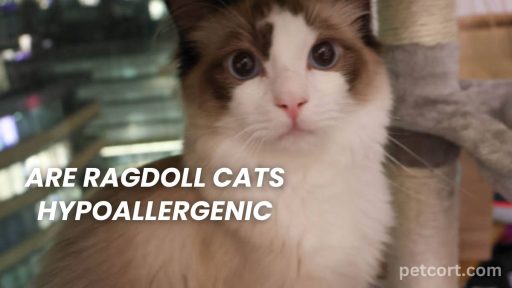Ragdoll cats are a beloved breed known for their stunning beauty, gentle personalities, and affectionate nature.
With their striking blue eyes, semi-long hair, and large size, these feline companions have captured the hearts of cat lovers worldwide.
However, whether ragdoll cats are hypoallergenic is a critical consideration for those with allergies.

This comprehensive guide will dive deep into cat allergies, exploring what causes them and the factors contributing to allergen production in different breeds.
We’ll also examine the myths and misconceptions surrounding hypoallergenic cats, providing you with the knowledge you need to decide whether a ragdoll cat is the right choice for you.
Contents
Understanding Cat Allergies
Before determining if ragdoll cats are hypoallergenic, it’s essential to understand the root cause of cat allergies. Contrary to popular belief, it’s not the fur that triggers allergic reactions but rather proteins found in a cat’s saliva, dander (dead skin cells), and urine.
The primary culprit is a protein called Fel d 1, produced in a cat’s skin, saliva, and urine. When a cat grooms itself, it spreads these proteins onto its fur. As the fur dries, the proteins become airborne, and people who are allergic can inhale them, triggering an allergic response.
Common Symptoms of Cat Allergies
Cat allergies can manifest in various ways, and the severity of symptoms can vary from person to person. Some of the most common symptoms include:
- Sneezing
- Runny or stuffy nose
- Itchy, watery eyes
- Coughing
- Wheezing
- Shortness of breath
- Skin rashes or hives
In severe cases, cat allergies can also trigger asthma attacks in people with asthma or other respiratory conditions.
Risk Factors for Cat Allergies
While anyone can develop an allergy to cats, certain factors can increase the risk:
- Family history of allergies
- Exposure to cats during childhood
- Asthma or other respiratory conditions
- Living in a home with poor air quality or ventilation
Are Ragdoll Cats Hypoallergenic?
Now, let’s address the central question: are ragdoll cats hypoallergenic? Unfortunately, there is no such thing as a 100% hypoallergenic cat breed. All cats produce the Fel d 1 protein that causes allergies, regardless of breed or hair length.
However, some cats may produce lower levels of this protein, making them more tolerable for people with mild allergies. So, where do ragdoll cats fall on this spectrum?
You May Also Like:
Orange Ragdoll Cat
Factors That Affect Allergen Levels in Ragdoll Cats
While ragdoll cats are not genuinely hypoallergenic, several factors can influence the amount of allergens they produce:
- Coat Length and Type: Ragdoll cats have semi-longhair coats, producing less dander than shorthaired cats. However, their longer hair can trap more saliva and dander, potentially increasing allergen levels.
- Grooming Habits: Well-groomed cats tend to have fewer allergens in their environment. Regular brushing and bathing can help reduce the amount of dander and saliva on a ragdoll cat’s coat.
- Sex: Male cats generally produce more Fel d 1 protein than females, so a female ragdoll cat may be better for allergy sufferers.
- Individual Variations: Even within the same breed, individual cats can vary in the amount of Fel d 1 protein they produce. Some ragdoll cats may be lower allergen producers than others.
Tips for Living with a Ragdoll Cat if You Have Allergies
If you have mild cat allergies and are considering getting a ragdoll cat, here are some tips to help minimize your exposure to allergens:
- Regular Grooming: Regularly brush and bathe your ragdoll cat to remove excess dander and saliva from their coat.
- Vacuum Frequently: Use a vacuum cleaner with a HEPA filter to remove pet dander and hair from your home.
- Use Air Purifiers: HEPA air purifiers can help remove airborne allergens from your living spaces.
- Keep the Cat Out of the Bedroom: Limiting your Cat’s access to your bedroom can help reduce exposure to allergens while you sleep.
- Consider Allergy Medication: Over-the-counter or prescription allergy medications may help alleviate your symptoms.
- Visit Your Allergist: If your allergies are severe, consult an allergist to develop a comprehensive management plan.
Breed Comparison: Ragdoll vs Other Cat Breeds
To better understand how ragdoll cats compare in terms of allergen production, let’s look at some other popular cat breeds:
| Breed | Coat Length | Potential for Allergens |
|---|---|---|
| Siberian | Semi-longhair | Potentially lower allergens |
| Bengal | Short | Average allergen levels |
| Persian | Longhair | Higher potential for allergens |
| Sphynx | Hairless | Potentially lower allergens |
| Russian Blue | Shorthair | Average allergen levels |
As you can see, while no cat breed is truly hypoallergenic, some breeds, like the Siberian and Sphynx, may produce fewer allergens than others, such as the Persian. Ragdoll cats fall somewhere in the middle, with their semi-longhair coats potentially producing fewer allergens than longhaired breeds but more than shorthaired breeds.
You May Also Like:
Grey Ragdoll Cat
Myths and Misconceptions About Hypoallergenic Cats
There are several common myths and misconceptions about hypoallergenic cats that need to be addressed:
Myth: Hairless Cats Are Hypoallergenic
While hairless breeds like the Sphynx may produce fewer allergens than longhaired cats, they still produce the Fel d 1 protein that causes allergies. They are not truly hypoallergenic.
Myth: Lighter-Colored Cats Are Less Allergenic
The color of a cat’s fur has no bearing on its allergen production. Both light and dark-colored cats can produce high or low levels of allergens.
Myth: All Longhaired Cats Are More Allergenic
While longhaired cats may trap more dander and saliva in their coats, some shorthaired breeds can also be high allergen producers. It depends on the individual cat and breed.
Alternatives for Allergy Sufferers
If you have severe cat allergies and cannot tolerate living with a cat, even a potentially low-allergen breed like the ragdoll, there are alternative pet options to consider:
Hypoallergenic Dog Breeds
While no dog breed is 100% hypoallergenic, some breeds are considered more allergy-friendly than others. These include:
- Poodles
- Portuguese Water Dogs
- Giant Schnauzers
- Maltese
- Soft-Coated Wheaten Terriers
Other Pets
If you’re open to non-traditional pets, you may want to consider:
- Fish
- Reptiles (e.g., lizards, snakes)
- Amphibians (e.g., frogs, salamanders)
- Birds (e.g., parrots, finches)
- Small mammals (e.g., guinea pigs, hamsters, rabbits)
Keep in mind that while these pets may not produce the same allergens as cats and dogs, they can still trigger allergies in some people. It’s always best to consult with an allergist before introducing a new pet into your home.
You May Also Like:
Grey Ragdoll Cat
Ragdoll Cat Allergy Management Strategies
If you’ve decided to welcome a ragdoll cat into your home despite having mild allergies, there are several strategies you can implement to manage your symptoms effectively:
Environmental Control
- Vacuum and Clean Regularly: Use a vacuum cleaner with a HEPA filter to remove pet dander, hair, and other allergens from your home. Vacuum carpets, upholstered furniture, and other areas where allergens can accumulate. Clean hard surfaces with a damp cloth or mop to remove dust and dander.
- Use HEPA Air Purifiers: HEPA air purifiers can help remove airborne allergens from your living spaces, providing cleaner air to breathe.
- Limit Access to Certain Areas: Consider designating certain rooms or areas of your home as “cat-free zones,” such as your bedroom, to reduce exposure to allergens while you sleep.
- Groom Your Cat Regularly: Regular brushing and bathing can help remove loose hair, dander, and saliva from your ragdoll cat’s coat, reducing the amount of allergens in your environment.
- Wash Bedding Frequently: Wash your bedding, including sheets, pillowcases, and blankets, in hot water weekly to remove any accumulated allergens.
Medication and Immunotherapy
- Over-the-Counter Antihistamines: Antihistamines can help alleviate allergy symptoms by blocking the body’s histamine response. However, they should be used with caution and under the guidance of a healthcare professional.
- Prescription Medications: Your allergist may prescribe medications such as nasal corticosteroids, leukotriene inhibitors, or immunotherapy (allergy shots) to help manage your cat allergies.
- Allergy Shots (Immunotherapy): Allergy shots, also known as immunotherapy, can be an effective long-term treatment for cat allergies. These shots gradually expose your body to small amounts of the allergen, helping to desensitize your immune system over time.
Monitoring and Adjustment
- Track Your Symptoms: Keep a log of your allergy symptoms and any potential triggers, such as increased exposure to your ragdoll cat or changes in your environment.
- Consult Your Allergist: If your symptoms persist or worsen, consult with your allergist to adjust your treatment plan or explore additional options.
- Consider Rehoming: In severe cases, where allergy management strategies are ineffective, you may need to consider rehoming your ragdoll cat to protect your health and well-being.
You May Also Like:
Mink Ragdoll
Conclusion
While ragdoll cats are not truly hypoallergenic, they may produce fewer allergens than some other cat breeds, making them a potentially better choice for people with mild cat allergies. However, it’s crucial to remember that individual cats can vary in their allergen production, and even within the same breed, some may be higher allergen producers than others.
If you have severe cat allergies, it’s best to consult with an allergist and explore alternative pet options that are more allergy-friendly. With proper management and precautions, it may be possible for some allergy sufferers to live comfortably with a ragdoll cat, but it’s essential to prioritize your health and well-being.
By understanding the factors that contribute to cat allergies and implementing effective management strategies, you can make an informed decision about whether a ragdoll cat is the right choice for your household.
FAQs
It’s possible to visit someone with a ragdoll cat if you have mild allergies, but it’s essential to take precautions. Consider taking allergy medication beforehand, and avoid prolonged exposure to the cat or areas where it spends a lot of time. If your allergies are severe, it may be best to avoid visiting homes with cats altogether.
No, there are no cat breeds that are 100% hypoallergenic. All cats produce the Fel d 1 protein that causes allergies, although some breeds may produce lower levels of this protein than others.
Allergy shots, also known as immunotherapy, can be an effective treatment for cat allergies. These shots gradually expose your body to small amounts of the allergen, helping to desensitize your immune system over time. Consult with an allergist to determine if this treatment option is suitable for you.
While DNA tests can provide insights into a cat’s genetic makeup, there is currently no reliable genetic test to determine if a particular cat will be a low or high allergen producer. Individual variations in allergen production can occur even within the same breed and litter.
If you have a ragdoll cat and suffer from allergies, it’s essential to maintain a rigorous cleaning routine. Vacuum frequently with a HEPA filter, wash your cat’s bedding and blankets regularly, and consider using HEPA air purifiers in your living spaces.
Share Your Friends






